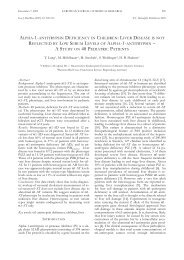European Journal of Medical Research - Deutsche AIDS ...
European Journal of Medical Research - Deutsche AIDS ...
European Journal of Medical Research - Deutsche AIDS ...
You also want an ePaper? Increase the reach of your titles
YUMPU automatically turns print PDFs into web optimized ePapers that Google loves.
June 27, 2007 EUROPEAN JOURNAL OF MEDICAL RESEARCH<br />
63<br />
der positiv getesteten Pt (9,3%) hatten in den letzten 12<br />
Monaten einen Krankenhausaufenthalt mit systemischer Antibiotikagabe.<br />
Vier Pt (9,3 %) hatten CD4 Helferzellen <<br />
200/l, 5 (11,6%) erhielten keine ART, darunter waren 3<br />
(7,0%) therapienaiv. Die Viruslast war bei allen 79 therapierten<br />
Pt < 400 cp/ml.<br />
Schlussfolgerung: Unsere Analyse zeigt, dass die SA<br />
Kolonisierung bei HIV signifikant häufiger ist als bei dem<br />
Kontrollkollektiv. Die Kolonisation mit SA bei HIV Pt ist unabhängig<br />
vom Immunstatus, einem Krankenhausaufenthalt<br />
oder Antibiotikagabe in den letzten 12 Monaten. Ob die hohe<br />
Prävalenz der Kolonisation mit den immunologischen Besonderheiten<br />
auch der behandelten HIV-Infektion oder mit anderen<br />
Faktoren assoziiert ist, wird Gegenstand weiterer Untersuchungen<br />
sein. Da die Frequenz der Ambulanzbesuche zwischen<br />
HIV-Infizierten und Kontrollpatienten nicht unterschiedlich<br />
ist, scheint eine lokal-endemische Ursache unwahrscheinlich.<br />
B.28 (Vortrag)<br />
CD4 cell reconstitution is impaired in patients with<br />
toxoplasma encephalitis as an <strong>AIDS</strong> indicator<br />
disease as compared to patients with<br />
pneumocystosis in the ClinSurv cohort<br />
Kastenbauer U. 1 , Kollan C. 2 , Hamouda O. 2 , Bogner J.R. 1 ,<br />
ClinSurv Studiengruppe<br />
1 Klinikum der LMU, Infektionsabteilung, München, Germany,<br />
2 Robert Koch Institut, Infektionsepidemiologie, Berlin,<br />
Germany<br />
Objectives: Toxoplasma encephalitis is still a relatively frequent<br />
<strong>AIDS</strong> indicating disease in Germany. Unlike in other<br />
opportunistic infections (OI), guidelines regarding the duration<br />
<strong>of</strong> secondary prophylaxis and treatment continuation are<br />
not available, probably due to the fact that this disease is less<br />
frequent in North America. There is no data on immune reconstitution<br />
in antiretroviral naïve patients with toxoplasmosis.<br />
The observation <strong>of</strong> several cases with a very slow increase<br />
<strong>of</strong> CD4 cells upon start <strong>of</strong> antiretroviral treatment (ART)<br />
prompted us to investigate the topic in the ClinSurv cohort.<br />
Methods: ClinSurv is an open multicentre observational cohort<br />
coordinated by the Robert Koch Institute collecting<br />
anonymised patient data on diagnoses, treatment, and laboratory<br />
items from 17 centres in a standardised format. Patients<br />
who met the following criteria were selected: diagnosis <strong>of</strong><br />
toxoplasmosis (TOXO) or pneumocystosis (PJP) between<br />
1999 and 2005, no ART prior to OI diagnosis, sufficient documentation<br />
<strong>of</strong> ART, CD4, viral load for at least 12 months.<br />
Descriptive analysis and group comparisons were performed<br />
using SPSS statistical package.<br />
Results: A total <strong>of</strong> 269 patients were eligible for analysis. 64<br />
patients were in the TOXO – und 205 in the PJP group. Demographic<br />
baseline data did not show significant differences<br />
with regard to gender, age (40.4 years), ethnicity, and baseline<br />
CD4 counts (71.8 vs 57.9 /l, p = 0.219). After six months<br />
and 12 months CD4 cells increased less rapidly in the TOXO<br />
versus the PJP group (99.2 vs 136.7 /l, p = 0.026; 12<br />
months: 154.1 vs 211.0 /l, p = 0.003). Viral load was higher<br />
in the PJP group at baseline (168641 vs 336684 /l, p =<br />
0.062), but the percentage <strong>of</strong> patients with VL below detection<br />
limit did not differ after 6 (74.2% vs. 78.7%, p = 0.458)<br />
and 12 months (80.7% vs 83.1%, p = 0.682).<br />
Conclusion: Our data shows for the first time that the average<br />
CD4 increase <strong>of</strong> patients with TOXO is slower as compared<br />
to PJP. This is important because most clinicians would not<br />
be prepared to discontinue follow up TOXO-therapy unless<br />
CD4 counts <strong>of</strong> 200 are reached. Explanations for our finding<br />
might be the myelosuppressive effect <strong>of</strong> pyrimethamine or not<br />
yet known interactions <strong>of</strong> TOXO therapy with ART.<br />
B.29 (Poster)<br />
Therapieunterschiede bei HIV-infizierten Frauen<br />
und Männern in einer monozentrischen deutschen<br />
HIV-Kohorte<br />
Balogh A. 1 , Mueck B. 1 , Koegl C. 1 , Wolf E. 1 ,<br />
Jaegel-Guedes E. 2 , Jaeger H. 2<br />
1 MUC <strong>Research</strong>, München, Germany, 2 Gemeinschaftspraxis<br />
Dr. Jaegel-Guedes - Dr. Jaeger, München, Germany<br />
Fragestellung: Sind innerhalb einer monozentrischen Kohorte<br />
von 1056 HIV-infizierten Patienten geschlechtsspezifische<br />
Unterschiede in der HIV-Therapie und im virologischen<br />
und immunologischen Ansprechen auf eine antiretrovirale<br />
Therapie zu erkennen?<br />
Methode: Prospektive Beobachtungsstudie von 1056 HIVpositiven<br />
Patienten (209 Frauen, 847 Männer), die seit Oktober<br />
2004 innerhalb der deutschlandweiten Patientenkohorte<br />
des Kompetenznetzes HIV/<strong>AIDS</strong> in unserer Praxis erfasst<br />
werden. Die Ergebnisse basieren auf einer „last observation<br />
carried forward“-Analyse.<br />
Ergebnisse: 21% der Frauen bzw. 15% der Männer waren<br />
therapienaiv. In Therapiepause befanden sich 1% der Frauen<br />
und 2% der Männer. 77% der Frauen und 83% der Männer<br />
wurden z.Zt. mit antiretroviralen Medikamenten behandelt,<br />
davon 37% der Frauen und 32% der Männer mit NRTI/PI-<br />
Kombinationen. 35% der Frauen und 32% der Männer wurden<br />
mit NRTI/NNRTI-Regimen behandelt. Frauen wurden<br />
signifikant häufiger mit dem NNRTI Nevirapin behandelt<br />
(Frauen: 25% NVP, 10% EFV; Männer: 14% NVP, 18%<br />
EFV; p





